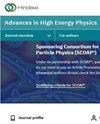关于洛伦兹不变复标量场
IF 1.5
4区 物理与天体物理
Q3 PHYSICS, PARTICLES & FIELDS
引用次数: 3
摘要
我们得到了一个洛伦兹协变波动方程,其复波函数在洛伦兹升压下根据以下规则变换:Ψ x川川市i / h f x Ψ x。我们证明了时空相关的相位f x是与非相对论性Schrödinger波函数的变换规则相关的相位的最自然的相对论性扩展,当它受到伽利略变换时。然后我们通过假设Ψ x在适当的洛伦兹变换(提升或空间旋转)下根据上述规则进行变换来推广前面的分析。这是与洛伦兹不变物理理论相容的最一般的变换规则,该理论的观测值是场Ψ x的双线性函数。我们用前面的波动方程来描述几种物理系统。特别地,我们解决了两个粒子的束缚态和散射问题,这两个粒子同时具有电磁和引力相互作用(静态电磁场和引力场)。前者通过最小耦合处方建模,后者通过外部电位进入。我们还制定了逻辑上一致的经典和量子场论与这些洛伦兹协变波动方程。我们证明,只要我们有不破坏洛伦兹不变性的自相互作用项,或者如果我们通过最小耦合处方引入电磁相互作用,就有可能使这些理论与克莱因-戈登理论等效。对于打破洛伦兹不变性的相互作用,我们表明,目前的理论暗示粒子和反粒子在衰变过程中的行为不同,后者更不稳定。这表明洛伦兹不变性破缺相互作用与物质-反物质不对称问题之间可能存在联系。本文章由计算机程序翻译,如有差异,请以英文原文为准。
On Lorentz Invariant Complex Scalar Fields
We obtain a Lorentz covariant wave equation whose complex wave function transforms under a Lorentz boost according to the following rule,
Ψ
x
⟶
e
i
/
ℏ
f
x
Ψ
x
. We show that the spacetime-dependent phase
f
x
is the most natural relativistic extension of the phase associated with the transformation rule for the nonrelativistic Schrödinger wave function when it is subjected to a Galilean transformation. We then generalize the previous analysis by postulating that
Ψ
x
transforms according to the above rule under proper Lorentz transformations (boosts or spatial rotations). This is the most general transformation rule compatible with a Lorentz invariant physical theory whose observables are bilinear functions of the field
Ψ
x
. We use the previous wave equations to describe several physical systems. In particular, we solve the bound state and scattering problems of two particles which interact both electromagnetically and gravitationally (static electromagnetic and gravitational fields). The former interaction is modeled via the minimal coupling prescription while the latter enters via an external potential. We also formulate logically consistent classical and quantum field theories associated with these Lorentz covariant wave equations. We show that it is possible to make those theories equivalent to the Klein-Gordon theory whenever we have self-interacting terms that do not break their Lorentz invariance or if we introduce electromagnetic interactions via the minimal coupling prescription. For interactions that break Lorentz invariance, we show that the present theories imply that particles and antiparticles behave differently at decaying processes, with the latter being more unstable. This suggests a possible connection between Lorentz invariance-breaking interactions and the matter-antimatter asymmetry problem.
求助全文
通过发布文献求助,成功后即可免费获取论文全文。
去求助
来源期刊

Advances in High Energy Physics
PHYSICS, PARTICLES & FIELDS-
CiteScore
3.40
自引率
5.90%
发文量
55
审稿时长
6-12 weeks
期刊介绍:
Advances in High Energy Physics publishes the results of theoretical and experimental research on the nature of, and interaction between, energy and matter. Considering both original research and focussed review articles, the journal welcomes submissions from small research groups and large consortia alike.
 求助内容:
求助内容: 应助结果提醒方式:
应助结果提醒方式:


